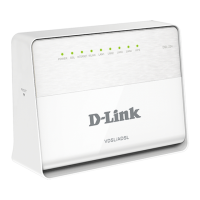Section 3 – Web Configuration
D-Link DSL-224 User Manual
ADVANCED
This section includes advanced features used for network management, security and administrative tools to manage the device. You can view status
and other information that are used to examine performance and troubleshoot.
Advanced Wireless
This function is used to modify the standard 802.11 wireless radio settings. It is recommended not to change the default settings, because incorrect
settings may impair the performance of your wireless radio. The default settings provide the best wireless radio performance in most environments.
Wireless Advanced
Choose ADVANCED >Advanced Wireless >Wireless Advanced
shown as the figure appears on the right.
In this page, you can configure the
wireless advanced parameters. It is recommended to use the default parameters.
The following table describes parameters in this page:
It is recommended to keep it as defaults.
Threshold
Set the threshold of fragmentation length. If the length of a
packet is greater than the value, the packet is
automatically fragmented into several packets. Because
too many packets lead to low performance of the wireless
network, the value of Fragmentation Threshold cannot
be too small. The default value is 2346.
Set the CTS/RTS threshold. If the length of a packet is
greater than the value, the router sends an RTS frame to
the destination station to negotiate. After
receiving the
RTS frame, the wireless station responds with a Clear to
Send (CTS) frame to the router, indicating that they can
communicate with each other. The default value is 2346.
Data Rate
Choose the transmission rate of the wireless data from
the dropdown list.
Preamble Type
Long Preamble: It means this card always use long
preamble.
Short Preamble: It means this card can support short

